All About Beans And Legumes
Introduction
Adzuki Beans
Anasazi Beans
Black Turtle Beans
Black-Eyed Peas
Garbanzo Beans or Chickpeas
Large Lima and Baby Lima Beans
Great Northern Beans
Green or Yellow Peas, Split or Whole
Kidney Beans
Green and Red Lentils
Mung Beans
Navy Beans
Pink Beans
Pinto Beans
Small Red Beans
Soybeans
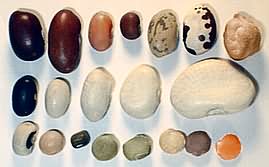
Introduction
What distinguishes beans from other plants? Beans have pods with seeds inside them. Aside from beans this includes peas, lentils and some people even include the peanut in this category. All legumes are able to take large amounts of nitrogen from the air and convert it to protein in the seeds. They also return large amounts of nitrogen to the ground and because of this the green plants are sometimes plowed under; as an organic fertilizer.
Right along with the early grains, legumes were among the first crops cultivated and date back to the Bronze Age. Beans have been discovered in the tombs of the Pharaohs and Aztecs. The ancient Egyptians considered beans to be an emblem of life and had temples dedicated to them. Later, the Greeks and Romans used them in festivals to worship their gods. The Roman's four most distinguished families were named after beans; Fabius (fava bean), Lentulus (lentil), Piso (pea), and Cicero (chickpea). Early discoverers learned that Indians scattered all over the Americas grew and ate numerous kinds of beans. And from the very beginning, beans were carried back and forth, traded and planted as explorers and nomads wondered the earth. In the Middle Ages beans were one of the primary foods of the peasants of Europe. And in more recent times because of their great storage ability, beans were a primary food for sailors which is exactly how the Navy bean got it's name. Beans have fed the armies of the world from ancient times to the wars of recent history. From the Great Depression right up to the present, beans have been recognized for their high nutritional content. At a small fraction of the cost of meat protein, one cup of cooked beans provides 25% of the daily requirement for the amino acids.
Nutrition
During the lean years of the Great Depression, beans were also tagged "poor man's meat" because of their protein power at pennies per pound. Beans are a source of Niacin, Thiamin, Riboflavin, B6 vitamins and many other nutrients as well. They are also rich in complex carbohydrates and fiber. All of these nutrients are necessary for normal growth and for the building of body tissues. Beans are high in potassium which is required for the normal functioning of nerves and muscles. A cup of cooked beans contains more potassium than a banana. In fact, beans have more calcium and iron per cup than three ounces of cooked meat but contain no cholesterol and with less calories.
Beans are the best source of folate and are excellent sources of minerals and vitamins. High in fiber they have good cancer fighting characteristics and have been specifically linked to lower the risk of colon cancer.
Recent research has brought to light that beans have 'anti-aging' agents or antioxidants found in the seed coat. There are eight flavonoids in the outer bean layer, six of which are particularly strong antioxidants. Because of new research, we are learning that beans have a perfect nutrient base for people interested in weight loss. They also aid in reducing cholesterol, improve digestion and, as already mentioned, are an aid in cancer prevention.
Beans are grown throughout the world. The legumes we supply come from the United States and are grown throughout the country on 1,700,000 acres of land producing from 1 to 1.4 million metric tons annually, half of which are exported all over the world. From improved agricultural practices, we feel beans grown right here at home in the USA have the highest quality of any bean grown anywhere.
Nutritional Content of the Different Legumes We Supply
Adzuki, Black Eye Peas, Black Turtle, Garbanzo, Great Northern
Kidney, Lentils, Lima, Mung, Pink
Pinto, Navy, Soy, Split Peas
Cooking Beans
Beans can be eaten raw, sprouted or cooked. Unknown by many, they can even be ground into a flour and in this form beans cook up in two or three minutes into a hearty soup. But this is not all, for the more adventurous among us, beans can be juiced into milk, curdled into tofu, fermented into soy sauce or made into transparent noodles called vermicelli. Truly, beans rival the versatility of wheat in what you can do with them. Let's look at some of the different processes in preparing beans for eating.
Soaking: This step isn't completely necessary, however, there are some real advantages. A shorter cooking time is probably the biggest advantage. Figure about an extra hour of cooking time for beans that are not pre-soaked. Beans should be soaked for at least 6 hours. During this time, the beans will absorb water until they have increased in volume and weight about 3 times. You should add 5 times as much water as dry beans. Soaking also leaches some of the gas producing properties out of the bean. But for this to work, you need to discard the soaking water and replenish it with fresh water before cooking. The longer you soak them the less gassy beans will be. You can also drain the water after 12 hours, then rinse and re-drain them every 12 hours for 2 to 3 days until the sprouts are as long as the bean. This not only dramatically increases the vitamins in the beans but also removes some of the gas producing qualities. After you have sprouted them as described above, cook them like regular soaked beans. You can also quick soak beans by boiling them for 10 minutes first, then setting them aside for two hours. As with a cold soak, you should discard the soaking water and replace with it fresh water before cooking them. Boiling the beans kills the seeds so don't expect them to sprout after you've heated them.
Cooking: After soaking, most people cover the beans with water then boil them. This can take anywhere from 30 minutes to 2 hours, depending on the bean. You should check them for softness every 15-30 minutes then pull them off the heat when they've reached their desired softness. But you can also throw them in a crock pot in the morning and let them go until the evening. And we've already mentioned that beans ground into a flour cook up almost instantly into a soup or paste, depending on how much water you use. If you've boiled your beans for several hours and they still haven't softened, it's probably because they are old. Old, air stored beans 5 or more years old get 'hardened' and may never soften up. There are two ways of getting around this. You can put them in a pressure cooker for 45-60 minutes and this should do the trick, or you can grind them. Incidentally, normal beans that aren't 'hard' cook in about 20 minutes is a pressure cooker. Hardened beans still contain much of their nutrition.
After your beans are cooked, add your flavorings, meat, vegetables or whatever you are adding to make the bean dish you are preparing. Don't add these ingredients while the beans are cooking as there are many ingredients that will increase the beans' cooking time before they become soft. This includes the acidic foods which include tomatoes, lemon juice, vinegar and similar ingredients. Adding a bit of cooking oil, butter or margarine to the cooking beans will help to keep the foaming down as they cook. Consider cooking a double batch and freezing the beans not used immediately. Beans soaked for 12 hours or more often have a more uniform shape than quick soaked beans. You may need to increase the cooking time if your water is overly hard or you live at high altitudes.
Cooked beans will store nicely in your refrigerator for a week and they freeze nicely for a minimum of 6 months.
One lb. dry packaged beans = 2 cups dry = 6 cups cooked beans.
Gas:
Beans have somewhat of a bad reputation because of their gas producing characteristics. However, there are several things you can do to minimize or eliminate this. The easiest thing you can do is pick a bean that is not as gas producing as the others. Gas is produced when the intestinal tract doesn't adequately digest beans.
The most likely reason for this is caused by a lack of enzymes needed to digest this food. As your body gets used to eating beans, the needed enzymes are introduced and this problem disappears. There's also a way of introducing these enzymes through a product called Beano. Beano contains alpha-galactosidase, an enzyme that helps digest the complex sugars that beans contain. (They also work on broccoli, cabbage and other gas producing foods.) There are a couple of herbs that also reduce or eliminate the gas from beans. From personal experience I've learned that a couple of '00 gel caps' stuffed with nutmeg will also do the trick and that peppermint, spearmint, marjoram, anise, basil, caraway, carrots, dill, ginger, onions orange juice, parsley, savory, thyme and ginger are also reported to have gas reduction properties to one extent or another as well. We've been drinking orange juice with our bean meals for years with good results. That old wives tale of throwing a carrot in with the beans as they cook then throw it out is also founded on successful experience.
As mentioned already, you should throw out the water you've been soaking your beans in before cooking them and it's also reported that fruits shouldn't be eaten at the same meal.
Adzuki Beans
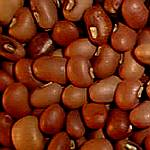 Traditionally, adzuki beans have been used in the Orient but are now becoming more popular here in the United States. Adzuki beans are small, round, dark red beans primarily used in making red bean paste for Chinese buns and for sweets. But they can also be used interchangeably with other beans in casseroles, soups and baked goods. Like the more traditional beans, adzuki beans should be soaked overnight then boiled and are a good substitute for small red beans although they have a lighter flavor. It's not a good idea to pressure cook this bean as they can sometimes develop a bitter flavor. Reconstituting at the same rate as standard beans, one cup of dry adzuki beans will make about 3 cups of cooked beans. Try this bean in rice dishes or salads. We think you'll like them.
Traditionally, adzuki beans have been used in the Orient but are now becoming more popular here in the United States. Adzuki beans are small, round, dark red beans primarily used in making red bean paste for Chinese buns and for sweets. But they can also be used interchangeably with other beans in casseroles, soups and baked goods. Like the more traditional beans, adzuki beans should be soaked overnight then boiled and are a good substitute for small red beans although they have a lighter flavor. It's not a good idea to pressure cook this bean as they can sometimes develop a bitter flavor. Reconstituting at the same rate as standard beans, one cup of dry adzuki beans will make about 3 cups of cooked beans. Try this bean in rice dishes or salads. We think you'll like them.
Anasazi Beans
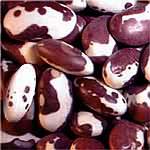 The anasazi bean is named after the extinct Anasazi or the Pueblo Indians. This new, yet ancient bean has the most amazing history behind it. One story has it that in the 1950s, archeologists in one of the Anasazi digs found a sealed, clay pot with a few of these beans in it. (Carbon dating determined them to be 1,500 years old.) Some of them sprouted and the modern anasazi beans all come from those few beans. As the Anasazi Indians left their homes in the late 1200s AD, however, this would have made those beans at a minimum 750 years old! (That is, if you ignore the carbon dating.) It's generally understood by seed viability specialists today that 50 years is about as long as a seed can remain viable which puts this story into question. There is another story that the first settlers who moved into this area found these beans growing wild around the Pueblo ruins then locally cultivated them. Years later, those same archeologists found the same kind of beans in that clay pot dating back to Anasazi times. I called up the company that patented and grows the anasazi bean. The sales representative told me the story is indeed true, some of those ancient seeds did sprout, but she added that most likely, the vast majority of the seeds they used to build up the crop probably came from local gardeners in the area. A California accountant, Ernis Waller learned of the bean and with his agronomist partner, Bruce Riddell's efforts, this bean has been brought to the public. The anasazi was first commercially sold around 1983. The anasazi bean is now just gaining a foot-hold in the market.
The anasazi bean is named after the extinct Anasazi or the Pueblo Indians. This new, yet ancient bean has the most amazing history behind it. One story has it that in the 1950s, archeologists in one of the Anasazi digs found a sealed, clay pot with a few of these beans in it. (Carbon dating determined them to be 1,500 years old.) Some of them sprouted and the modern anasazi beans all come from those few beans. As the Anasazi Indians left their homes in the late 1200s AD, however, this would have made those beans at a minimum 750 years old! (That is, if you ignore the carbon dating.) It's generally understood by seed viability specialists today that 50 years is about as long as a seed can remain viable which puts this story into question. There is another story that the first settlers who moved into this area found these beans growing wild around the Pueblo ruins then locally cultivated them. Years later, those same archeologists found the same kind of beans in that clay pot dating back to Anasazi times. I called up the company that patented and grows the anasazi bean. The sales representative told me the story is indeed true, some of those ancient seeds did sprout, but she added that most likely, the vast majority of the seeds they used to build up the crop probably came from local gardeners in the area. A California accountant, Ernis Waller learned of the bean and with his agronomist partner, Bruce Riddell's efforts, this bean has been brought to the public. The anasazi was first commercially sold around 1983. The anasazi bean is now just gaining a foot-hold in the market.
The anasazi is a white bean with a maroon patern and is a cousin to the pinto bean. They have a flavorful, sweet taste and are easier to digest and therefore cause less gas than the other beans. Interestingly, the anasazi bean only has 25% of the gas producing properties of the pinto which falls roughly in the middle of the gas producing scale. Like the other beans, they rehydrate to three times their size but cook in less time than similar beans their size. Anasazi beans can be substituted for pinto or red kidney beans in your favorite dishes. Not just another bean, the anasazi is flavorful, adaptable, and full of nutrition. And eating them gives one a sense of being in touch with the ancient Indians who gave them to us.
Black Turtle Beans
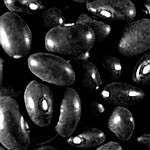 The black turtle bean is a small, black, oval shaped bean. They turn a dark brown color when cooked. This is a common bean in South and Central American and is also popular in China where it is fermented for many uses. When cooked with other beans, the color from the black turtle runs through the other beans giving the whole pot a dark color. Black turtle beans tend to break up when cooked. You can lessen this by not pre-soaking them. They also loose their skins quite easily and might not be a good candidate for the pressure cooker because of this as the skins might plug up the pressure regulating valve.
The black turtle bean is a small, black, oval shaped bean. They turn a dark brown color when cooked. This is a common bean in South and Central American and is also popular in China where it is fermented for many uses. When cooked with other beans, the color from the black turtle runs through the other beans giving the whole pot a dark color. Black turtle beans tend to break up when cooked. You can lessen this by not pre-soaking them. They also loose their skins quite easily and might not be a good candidate for the pressure cooker because of this as the skins might plug up the pressure regulating valve.
High in iron, the black turtle bean has an earthy, sweet flavor with a hint of mushrooms. They cook up in 1 to 1-1/2 hours, expanding three times their dry size and are often served in thick soups with rice. This bean is a basic staple for many Mexican, Caribbean and Latin American soups and side dishes.
Black-Eyed Peas
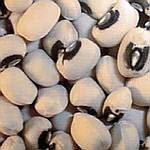 Black-eyed peas are actually a small, almost white bean with a black spot along their side. Originally brought to the United States by slave traders, this bean has been a popular food in the Southern US for hundreds of years. These beans, sometimes referred to as cowpeas, are also popular in Africa in different fermented dishes. In India they are often eaten like lentils.
Black-eyed peas are actually a small, almost white bean with a black spot along their side. Originally brought to the United States by slave traders, this bean has been a popular food in the Southern US for hundreds of years. These beans, sometimes referred to as cowpeas, are also popular in Africa in different fermented dishes. In India they are often eaten like lentils.
Thin skinned black-eyed peas cook up in only 30 to 60 minutes and require no presoaking. Traditionally served with rice or corn bread, they remain a popular Southern cuisine. On New Year's Day in the South there's a tradition of black-eyed peas being made into Hoppin' John which has the reputation of bringing good luck. Black-eyed peas cooked with onion, garlic and tomato sauce make a delicious dish.
Garbanzo Beans or Chickpeas
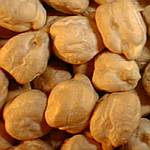 Garbanzo beans are believed to be one of the oldest cultivated beans, dating back as far as 5400 BC. It has a light tan color and has more of a square-ish, nutty look than the other beans. Considered a medium sized bean, they cook in 1 to 1-1/2 hours and go well in soups, salads and Mexican dishes. They are also the main ingredient in hummus and falafel, popular Middle Eastern dishes. After cooking, this versatile bean remains nice and firm and has a nut-like flavor. They can be made into a coffee-like drink if roasted brown then ground.
Garbanzo beans are believed to be one of the oldest cultivated beans, dating back as far as 5400 BC. It has a light tan color and has more of a square-ish, nutty look than the other beans. Considered a medium sized bean, they cook in 1 to 1-1/2 hours and go well in soups, salads and Mexican dishes. They are also the main ingredient in hummus and falafel, popular Middle Eastern dishes. After cooking, this versatile bean remains nice and firm and has a nut-like flavor. They can be made into a coffee-like drink if roasted brown then ground.
Large Lima and Baby Lima Beans
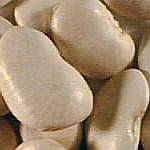
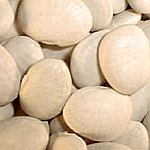 Lima beans, sometimes called butter beans, are a flat-shaped, creamy white-colored bean. They have a smooth, creamy, sweet flavor and cook up in 1 to 1-1/2 hours. They are a popular vegetable side-dish and are also added to soups and casseroles. Having a distinct flavor all their own, these beans make a delicious and hearty soup all by themselves. They also go well with rice or cornbread. When cooked, lima beans are quite soft and won't hold their shape well if roughly handled. Lima beans are different enough from the other beans that they can seem like a nice break from "beans" when eating a large variety of different legumes in the diet.
Lima beans, sometimes called butter beans, are a flat-shaped, creamy white-colored bean. They have a smooth, creamy, sweet flavor and cook up in 1 to 1-1/2 hours. They are a popular vegetable side-dish and are also added to soups and casseroles. Having a distinct flavor all their own, these beans make a delicious and hearty soup all by themselves. They also go well with rice or cornbread. When cooked, lima beans are quite soft and won't hold their shape well if roughly handled. Lima beans are different enough from the other beans that they can seem like a nice break from "beans" when eating a large variety of different legumes in the diet.
Great Northern Beans
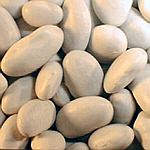 The great northern bean is a white, oval shaped medium sized bean about twice the size of navy beans and black-eyed peas. The great northern bean has a mild flavor with a powdery texture and is used in the same dishes as the more common navy bean. They are great in baked beans, casseroles and anywhere a mild flavored bean is called for. They cook in approximately 1 hour and are most often used in soups, stews and casseroles and can be substitutes for navy beans or lima beans.
The great northern bean is a white, oval shaped medium sized bean about twice the size of navy beans and black-eyed peas. The great northern bean has a mild flavor with a powdery texture and is used in the same dishes as the more common navy bean. They are great in baked beans, casseroles and anywhere a mild flavored bean is called for. They cook in approximately 1 hour and are most often used in soups, stews and casseroles and can be substitutes for navy beans or lima beans.
Green or Yellow Peas, Split or Whole
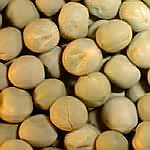
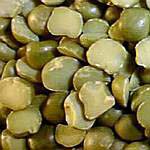
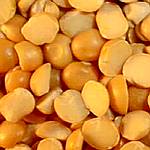 Whole peas need to be soaked whereas split peas do not. The whole pea can also be sprouted which increases it's sweetness, vitamins and enzymes. When dried peas are cooked, they seem to melt right into the liquid in which they are cooked. This is especially true of split peas that have their skins removed before they are split. Delicious in flavor, peas and split peas go well in soups and casseroles. Who can turn down a bowl of split pea soup? When ground first, peas can be made into a split pea soup in about 3 minutes. And ground peas make an excellent thickener for other dishes, adding a robust flavor all their own. They can also be an ingredient in meatless patties. Yellow split peas have a milder flavor and are good to use in dishes where you want to hide the richer, green pea flavor.
Whole peas need to be soaked whereas split peas do not. The whole pea can also be sprouted which increases it's sweetness, vitamins and enzymes. When dried peas are cooked, they seem to melt right into the liquid in which they are cooked. This is especially true of split peas that have their skins removed before they are split. Delicious in flavor, peas and split peas go well in soups and casseroles. Who can turn down a bowl of split pea soup? When ground first, peas can be made into a split pea soup in about 3 minutes. And ground peas make an excellent thickener for other dishes, adding a robust flavor all their own. They can also be an ingredient in meatless patties. Yellow split peas have a milder flavor and are good to use in dishes where you want to hide the richer, green pea flavor.
Kidney Beans
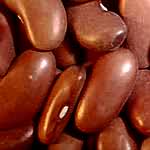 Kidney beans are a robust bean with a full bodied flavor and soft texture. They can come in many different sizes and colors but in the US are a predominantly dark red, kidney shaped bean. They are mostly used in making chili but are also widely used in salads and rice dishes.
Kidney beans are a robust bean with a full bodied flavor and soft texture. They can come in many different sizes and colors but in the US are a predominantly dark red, kidney shaped bean. They are mostly used in making chili but are also widely used in salads and rice dishes.
Kidney beans cook in 1-1/2 to 2 hours after being soaked for several hours. This bean is very popular in Mexican, Brazilian and Chinese dishes. Kidney beans go well in most any dish calling for a large, firm bean.
Green and Red Lentils
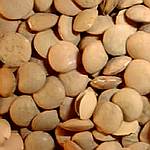
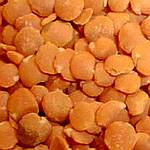 Lentils are a separate branch of the legume family tree and look like small, flat round disks. Lentils come in a huge variety of colors and flavors ranging from black to orange to green. Lentils need no presoaking, cook in only 45 minutes and have a pleasant, peppery flavor. Lentils are a very popular legume used throughout much of the world. Brown lentils don't hold their shape well after being cooked, however green lentils do.
Lentils are a separate branch of the legume family tree and look like small, flat round disks. Lentils come in a huge variety of colors and flavors ranging from black to orange to green. Lentils need no presoaking, cook in only 45 minutes and have a pleasant, peppery flavor. Lentils are a very popular legume used throughout much of the world. Brown lentils don't hold their shape well after being cooked, however green lentils do.
Lentils have a high nutritional value second only to soy beans in protein content. They make a great soup all by themselves and can also be ground and made into meatless patties. Lentils sprout in two days, being crisp and sweet, they are a great addition to salads. Lentils have been a popular food in the Middle East for thousands of years. Lentils are mentioned 4 times in the bible, the first time being in that bowl of pottage Jacob gave Esau as he forsook his birthright about 4,160 years ago.
Mung Beans
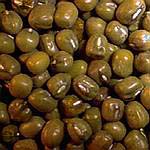 The mung bean is a very small, round bean closely related to the field pea. Here in the United States, mung beans are chiefly sprouted and are the main sprout here in grocery stores. Mung bean sprouts are characterized by their crisp, nutty flavor, ideal for stir fry and are also commonly eaten raw in salads. Mung beans are also used in Indian recipes skinned and split to make dal (sometimes written as dhaal, dhal or dhall.). The Sri Lankans use them to make idli. Split peas can also be substituted for this purpose. Mung beans are also considered low on the gas producing scale.
The mung bean is a very small, round bean closely related to the field pea. Here in the United States, mung beans are chiefly sprouted and are the main sprout here in grocery stores. Mung bean sprouts are characterized by their crisp, nutty flavor, ideal for stir fry and are also commonly eaten raw in salads. Mung beans are also used in Indian recipes skinned and split to make dal (sometimes written as dhaal, dhal or dhall.). The Sri Lankans use them to make idli. Split peas can also be substituted for this purpose. Mung beans are also considered low on the gas producing scale.
Navy Beans
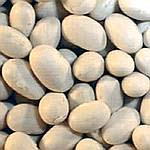 The navy bean, also known as the pea bean, originates from Italy and is prized for it's smooth texture and nutty flavor. The 'white pea bean' was such a popular food on America's early naval vessels it became known as the navy bean. It is a small white oval, mild flavored bean that when cooked has a powdery texture. They are most often used when making pork and beans or baked beans. Most always found in minestrone soup, they can also be used in other soups and stews. One cup of dry beans makes about 2-1/2 cups of cooked beans and takes about 1-1/2 to 2 hours for them to cook. The navy bean substitutes well for great northern beans or baby limas and is also good in salads.
The navy bean, also known as the pea bean, originates from Italy and is prized for it's smooth texture and nutty flavor. The 'white pea bean' was such a popular food on America's early naval vessels it became known as the navy bean. It is a small white oval, mild flavored bean that when cooked has a powdery texture. They are most often used when making pork and beans or baked beans. Most always found in minestrone soup, they can also be used in other soups and stews. One cup of dry beans makes about 2-1/2 cups of cooked beans and takes about 1-1/2 to 2 hours for them to cook. The navy bean substitutes well for great northern beans or baby limas and is also good in salads.
Pink Beans
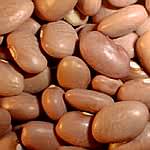 Pink beans are small, pale, pink-colored beans with a rich, meaty flavor and a slightly powdery texture. Requiring about an hour to cook after being soaked, the pink bean is a relative of the kidney bean and turns a reddish brown when cooked. The pink bean is a favorite in chili making and can be found in many other Old West recipes as well. You can substitute the pink bean for red kidney beans or pinto beans in any recipe that calls for them.
Pink beans are small, pale, pink-colored beans with a rich, meaty flavor and a slightly powdery texture. Requiring about an hour to cook after being soaked, the pink bean is a relative of the kidney bean and turns a reddish brown when cooked. The pink bean is a favorite in chili making and can be found in many other Old West recipes as well. You can substitute the pink bean for red kidney beans or pinto beans in any recipe that calls for them.
Pinto Beans
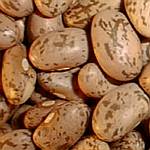 The pinto bean, a member of the kidney bean family, is an oval shaped, tan colored bean that's mottled with a light brown pattern on it's shell. It's very popular across the Southern United States and is the most common bean eaten in the US with a consumption rate of almost 45% of all the beans eaten. Part of the reason for this is they are generally the cheapest bean you can purchase. But that doesn't mean they are cheap in nutrition or flavor. The nutrition in pinto beans compare favorably with their higher priced cousins and they have a pleasant, earthy flavor and powdery texture that blends with many other foods. They are popular for making chili, soups and baked beans and can be substituted for recipes calling for kidney or red beans. After soaking, pinto beans require about 1-1/2 to 2 hours to cook, increasing 3 times their dry volume during which time they lose their mottling and turn a nice brown color. Pinto beans are a favorite when making refried beans and are great in Tex-Mex and Mexican bean dishes. You can safely substitute pinto beans when your recipe calls for kidney, anasazi, Roman or borlotti beans.
The pinto bean, a member of the kidney bean family, is an oval shaped, tan colored bean that's mottled with a light brown pattern on it's shell. It's very popular across the Southern United States and is the most common bean eaten in the US with a consumption rate of almost 45% of all the beans eaten. Part of the reason for this is they are generally the cheapest bean you can purchase. But that doesn't mean they are cheap in nutrition or flavor. The nutrition in pinto beans compare favorably with their higher priced cousins and they have a pleasant, earthy flavor and powdery texture that blends with many other foods. They are popular for making chili, soups and baked beans and can be substituted for recipes calling for kidney or red beans. After soaking, pinto beans require about 1-1/2 to 2 hours to cook, increasing 3 times their dry volume during which time they lose their mottling and turn a nice brown color. Pinto beans are a favorite when making refried beans and are great in Tex-Mex and Mexican bean dishes. You can safely substitute pinto beans when your recipe calls for kidney, anasazi, Roman or borlotti beans.
Small Red Beans
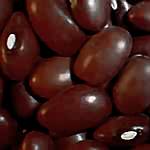 Smaller than the pinto or kidney bean, the small red bean, also called the Mexican Red Bean, holds it's shape and firmness when cooked. It is most often used in soups, salads, chili and Creole dishes. Nearly all of the US crop is grown in Idaho and Washington.
Smaller than the pinto or kidney bean, the small red bean, also called the Mexican Red Bean, holds it's shape and firmness when cooked. It is most often used in soups, salads, chili and Creole dishes. Nearly all of the US crop is grown in Idaho and Washington.
Soybeans
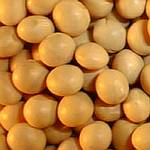 Soybeans are the single most economically important bean in the world. They have the highest protein content and are an important oil seed. Because of their relatively high oil content for a bean, this small, round, usually tan colored bean must be protected from oxygen if it is to be stored for a longer period than one year. As soybeans, by themselves have a flavor that not everyone can appreciate, they are rarely eaten by themselves but are made into other foods such as TVP, soy milk, tofu, tempeh, minse, soysauce, natto, sprouts and other foods.
Soybeans are the single most economically important bean in the world. They have the highest protein content and are an important oil seed. Because of their relatively high oil content for a bean, this small, round, usually tan colored bean must be protected from oxygen if it is to be stored for a longer period than one year. As soybeans, by themselves have a flavor that not everyone can appreciate, they are rarely eaten by themselves but are made into other foods such as TVP, soy milk, tofu, tempeh, minse, soysauce, natto, sprouts and other foods.
The soybean was first recorded as a domesticated plant around the 11th century, BC in Northeast China. By the first century, AD, the plant could be found in most parts of China and bordering countries as well. Through the next 14 centuries, the soybean slowly spread throughout the rest of Asia and has for centuries been the mainstay of East Asian nutrition. The soybean didn't reach Europe until 1737. In 1765 soybeans were first introduced into America by a seaman, Samuel Bowen, and in 1770 Benjamin Franklin, on a trip to London, sent soybean seeds to America. It seems probable, however that all of these introductions were temporary in nature.
The soybean was first commercially grown in Illinois. In 1851, Dr. Benjamin Franklin Edwards obtained soybean seeds from the Japanese and brought them to Alton, Illinois, where they were planted in John Lea's garden. From this reintroduction of the Soybean, along with some early stock from the Perry Expedition, came the stock that was to fuel the massive commercial venture here in the United States.
Soybeans not only contain the highest level of protein of any other bean, the amino acid balance in them is close enough to human needs that they can be considered a complete protein in and of themselves. They are an excellent source of iron, calcium, phosphorus, magnesium and the B vitamins. Soybeans are the best source of lecithin which reduces cholesterol levels in the bloodstream. It is also a great source of the essential oil, linolenic acid and a good source of vitamin E.
Foods Made From Soybeans
Tofu: Tofu is an ancient food that has been with us for at least 2000 years. It is a white, cheese-like substance, full of protein that can be used in place of meat. Tofu is a great food for people with sensitive stomachs as it is 95% digestible, one of the higher foods on the list. Fresh tofu smells and tastes mildly sweet. Aged tofu has a vinegary smell and flavor. Freezing tofu will help to remove it's moisture as water separates out when it thaws. You can also press the moisture out. Well pressed tofu is firm and has the usability of a steak. You can also blend tofu into a creamy texture in making dips, spreads, puddings and pies. Tofu picks up the flavor of the other foods it's prepared with. This is a great nutritional source and can be easily made at home, costing pennies as compared to what it would cost at the store.
Soy Sauce: Soy beans are fomented for as long as two years in cedar vats in the making of soy sauce. One of it's primary uses in the orient is to marinate tofu, giving tofu a rich, full flavor. It's also excellent as a seasoning in soups, vegetables, dressings and rice. Try marinating skinned chicken in soy sauce and garlic for several hours before cooking - Good!
Miso: Miso is a paste that comes from fermented soybeans. It is an excellent source of bacteria and enzymes that aid digestion and has a really great flavor. Soy Milk has as much protein as cows milk but is lower in fat and has no cholesterol. Many people like to give it to infants in place of cows milk as it is easier for them to digest. Soy milk, easy to make at home, can then be made into tofu. As mentioned above for tofu, you can make your own soy milk from soybeans for a tiny fraction of what it costs to purchase it in the store.
Soy Flour: Soybeans can be ground in impact grinders or in manual grinders that use burrs. You can also get a coarse grind by putting them in a blender. Try putting 1/2 cup of soy flour in your next batch of bread. The soy will, to a certain degree, act as a binder and at the same time you'll be giving a real 'nutritional shot in the arm' to your loaf at the same time.
Soybean Oil: Soybeans are only 18% oil, making their oil yield low for an oil bearing seed. Cold-pressed unrefined soybean oil is of the highest quality and delicious in flavor. Soybean oil contains omega 3, omega 6 and omega 9 fatty acids, lecithin, phytosterols and has many other natural properties that help fight against various cancers.
TVP (Textured Vegetable Protein): TVP is intended to imitate meat. It is made from soybean flour and contains about 50% protein, twice as much protein as most meats. The amino acids in TVP are balanced well enough that you can consider them a balanced protein, just like meat.
Soy Sprouts: Soybeans, being easy to sprout, are packed with vitamins and enzymes making them more digestible and healthy than the unsprouted seed. Many people consider this as the optimum way to eat soybeans.